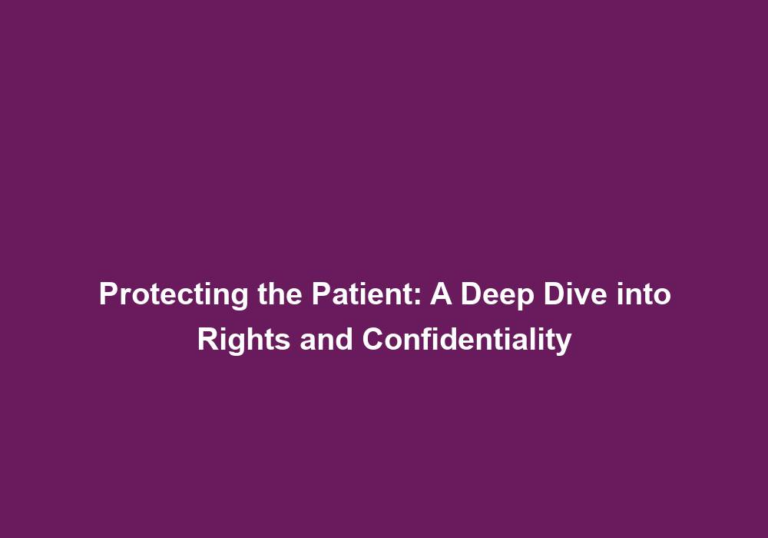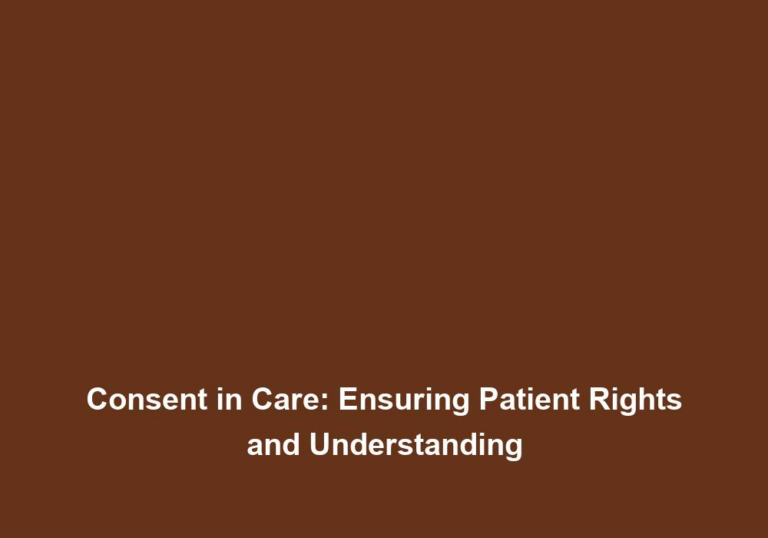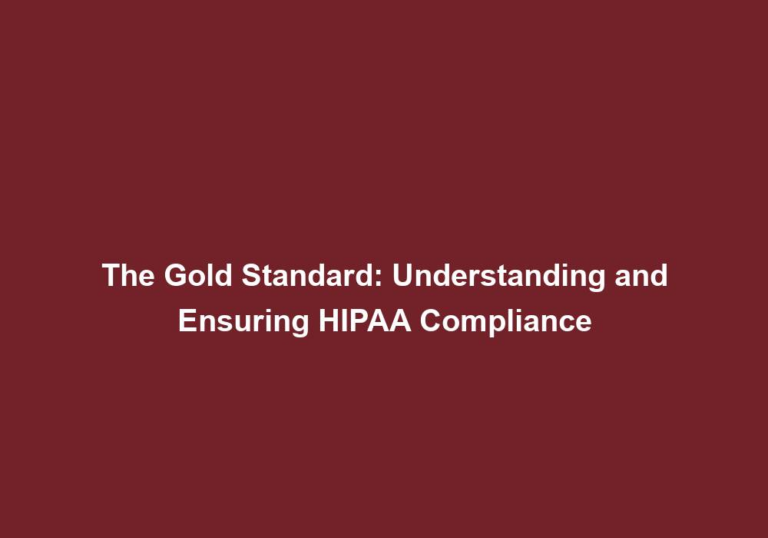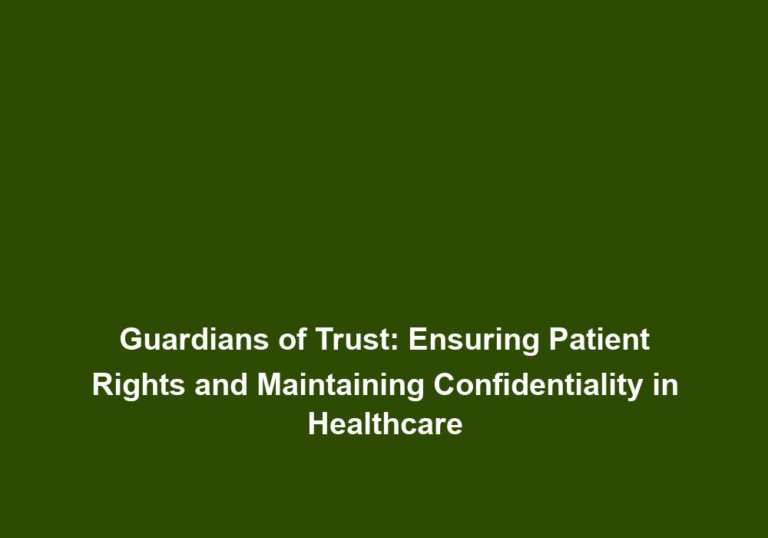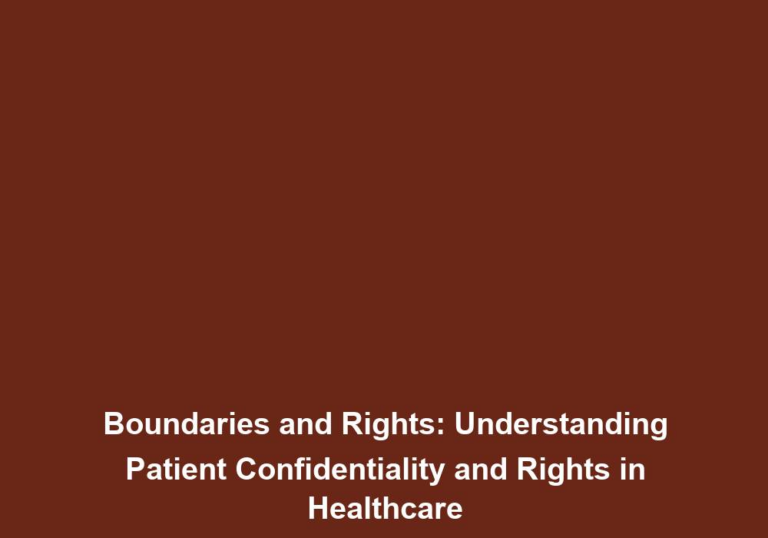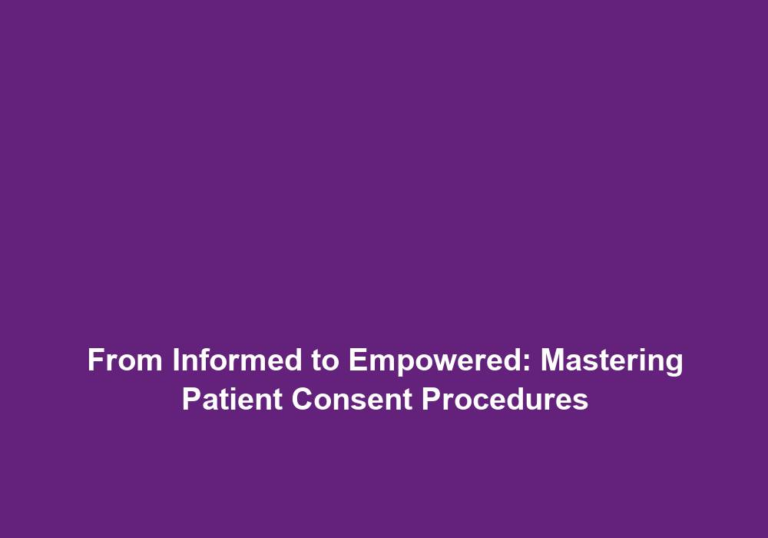Permission to Proceed: Navigating Patient Consent Processes
In the healthcare industry, obtaining patient consent is a crucial aspect of providing high-quality care and maintaining ethical standards. Patient consent ensures that individuals have the necessary information to make informed decisions about their healthcare options and gives healthcare providers the legal and ethical framework to proceed with certain treatments or procedures. Navigating the patient consent process can be complex, with various considerations and legal requirements to uphold. In this article, we will explore the importance of patient consent, the different types of consent, and how healthcare providers can effectively navigate the consent process.
Why is Patient Consent Important?
Patient consent serves as the foundation of ethical healthcare practices. It empowers patients to actively participate in their own care, respects their autonomy, and fosters trust between patients and healthcare providers.
By obtaining consent, healthcare professionals ensure that patients are fully aware of the risks, benefits, and alternatives associated with a particular treatment or procedure. This allows patients to make informed decisions that align with their values, preferences, and overall well-being.
In addition to empowering patients, patient consent also protects healthcare providers from potential legal or ethical consequences. Without proper consent, healthcare professionals may face accusations of medical malpractice, violation of patient rights, or breach of confidentiality. Thus, patient consent is not only an ethical imperative but also a legal requirement that should be strictly adhered to.
Some key reasons why patient consent is important include:
-
Respecting Autonomy: Patient consent allows individuals to exercise their autonomy and have control over their own healthcare decisions. It respects their right to choose what is best for them based on their values, beliefs, and preferences.
-
Building Trust: Obtaining consent helps build trust between patients and healthcare providers. When patients feel that their healthcare provider values their opinion and respects their rights, they are more likely to have confidence in the care they receive.
-
Informed Decision-Making: Consent ensures that patients have access to all relevant information about their condition, treatment options, potential risks, benefits, and alternatives. This enables them to make informed decisions that align with their goals and values.
-
Legal Protection: Proper consent documentation provides legal protection for healthcare providers. It serves as evidence that patients were fully informed and gave their voluntary consent for a specific treatment or procedure, reducing the risk of potential legal consequences.
Types of Patient Consent
- Implied Consent: Implied consent is often assumed in routine healthcare interactions where patients seek general medical advice, vaccinations, or undergo routine examinations. In these situations, patients typically present themselves willingly, implicitly indicating their consent for the healthcare professional to proceed with necessary care.
Implied consent is based on the assumption that patients understand the nature of the interaction and agree to receive the standard care associated with the situation. For example, when a patient schedules an appointment with a primary care physician for a routine check-up, they implicitly consent to the physician conducting necessary examinations and providing appropriate advice or treatment.
- Verbal Consent: Verbal consent involves explicit communication between the healthcare provider and the patient. This type of consent is commonly used in outpatient settings, consultations, or non-invasive procedures. Verbal consent ensures that patients understand the treatment or procedure, its potential risks, and alternative options before giving their consent verbally.
During the consent process, healthcare providers engage in a conversation with the patient, explaining the proposed treatment or procedure, discussing any potential risks or side effects, and answering any questions the patient may have. The patient then verbally confirms their understanding and agreement to proceed with the recommended course of action.
- Written Consent: Written consent is essential for more invasive or complex procedures, such as surgeries or experimental treatments. This written documentation serves as evidence that patients comprehend the risks involved and have given their informed consent to proceed. In some cases, written consent may also be required for certain medical research studies or participation in clinical trials.
Written consent forms typically include detailed information about the procedure or treatment, potential risks and benefits, alternative options, and an opportunity for patients to ask questions or seek clarification. The patient then signs the document, indicating their understanding and agreement to proceed.
- Informed Consent: Informed consent encompasses both the process and documentation of obtaining consent. It involves providing patients with comprehensive and understandable information about their condition, proposed treatment, potential risks, benefits, and alternatives. Informed consent should be obtained voluntarily, free from coercion, and without any undisclosed information or hidden agendas.
To ensure informed consent, healthcare providers should present information in a clear and unbiased manner, using plain language and visual aids when necessary. They should allow patients ample time to review the information, ask questions, and seek additional information from reliable sources before making a decision.
Navigating the Patient Consent Process
Navigating the patient consent process can be challenging, particularly with the ever-evolving landscape of healthcare regulations and legal obligations. Here are some key steps and considerations to effectively manage the patient consent process:
Step 1: Establish a Clear Consent Policy
Developing a comprehensive consent policy is essential for healthcare organizations to ensure consistency and compliance. This policy should outline the different types of consent required for various procedures, treatments, or research studies. It should also specify any additional requirements, such as obtaining consent from guardians for minors or patients with diminished mental capacity.
A clear consent policy helps healthcare providers understand the specific consent requirements for different scenarios, ensuring that they adhere to legal and ethical standards. It provides guidelines for obtaining consent in a consistent manner, reducing the risk of misunderstandings or omissions.
Step 2: Educate Healthcare Providers
Healthcare providers play a critical role in obtaining valid consent from patients. They should receive thorough training on the importance of consent, legal requirements, and effective communication techniques. This education should emphasize the need to present information in a clear, unbiased manner, allowing patients to ask questions and seek clarification before giving their consent.
By educating healthcare providers, organizations ensure that their staff is well-equipped to navigate the consent process and communicate effectively with patients. Training should cover topics such as the importance of patient autonomy, the legal implications of consent, strategies for effective communication, and cultural considerations that may impact the consent process.
Step 3: Communicate Effectively with Patients
Open and transparent communication is vital throughout the consent process. Healthcare providers must ensure that patients fully understand the proposed treatment, potential risks, benefits, and alternatives. Using plain language, avoiding medical jargon, and visual aids can enhance patient comprehension. Encouraging patients to ask questions and seek additional information fosters a collaborative decision-making process.
During the consent process, healthcare providers should actively listen to patients, address their concerns, and provide information in a way that is easily understandable. They should use clear and concise language, avoiding technical terms or complex explanations that may confuse patients. Visual aids, such as diagrams or videos, can also help illustrate complex concepts and facilitate patient understanding.
Step 4: Document Consent Properly
Accurate and complete documentation of consent is crucial. This documentation should include the patient’s signature or acknowledgement, the date, and the specific treatment or procedure to which the consent applies. In cases where written consent is required, healthcare providers should ensure that the document is explicit, easy to read, and covers all necessary information.
Properly documenting consent provides a record of the patient’s agreement to proceed with a specific treatment or procedure. It serves as evidence that the patient was informed of the risks, benefits, and alternatives and voluntarily gave their consent. Documentation also helps healthcare providers track the consent process, ensuring compliance with legal and organizational requirements.
Step 5: Regularly Review and Update Consent Processes
Consent processes should be regularly reviewed and updated to reflect changes in regulations, best practices, and patient expectations. This ensures that healthcare organizations stay in line with current standards and can adapt to new challenges or advancements in medical treatments. Regular training and education sessions also facilitate ongoing compliance and improve the overall consent process.
Healthcare organizations should establish mechanisms to periodically review their consent policies, procedures, and documentation templates. This review process should involve stakeholders from various departments, including legal, ethics, and patient advocacy, to ensure a comprehensive evaluation. Feedback from patients and healthcare providers can also provide valuable insights for process improvement.
Conclusion
Patient consent is a fundamental aspect of ethical healthcare practices. By obtaining valid consent, healthcare providers empower patients to make informed decisions about their care, foster trust, and ensure legal compliance. Navigating the patient consent process requires clear policies, education for healthcare providers, effective communication with patients, proper documentation, and regular reviews to uphold best practices. Upholding the principles of patient consent not only respects patients’ rights but also contributes to the overall delivery of high-quality healthcare.


